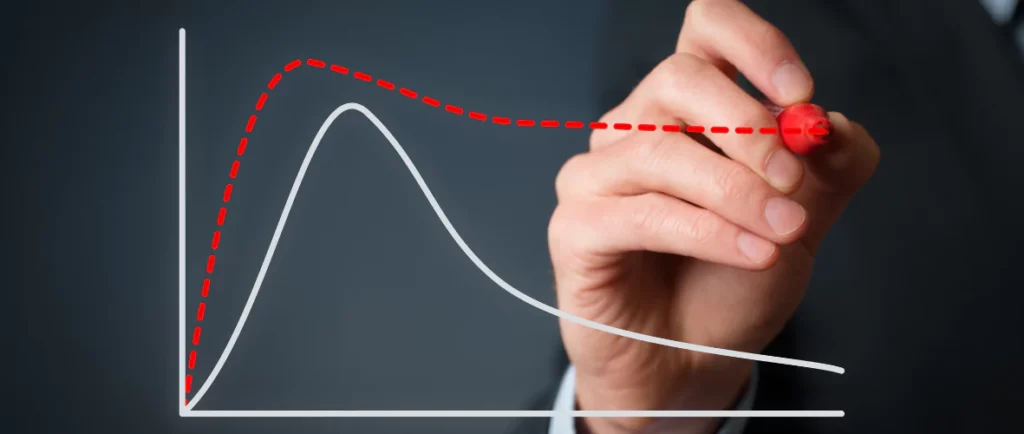A common description of the cryptocurrency industry is that it is unpredictable. It seems as though prices fluctuate wildly. Beneath this seeming disorder, though, are observable trends called market cycles. Understanding these cycles might help investors make better choices and possibly increase their profits. Discover how to decipher these patterns as we delve into the intriguing realm of cryptocurrency market cycles.
Phases of Cryptocurrency Market Cycles
The four distinct phases of cryptocurrency market cycles are accumulation, markup, distribution, and markdown. Investors can use the distinct traits and indicators of each phase to determine the direction of the market.
Accumulation Phase
A market cycle begins with the accumulation phase. Prices are rather steady during this stage, and investor mood is typically negative. Many investors are reluctant to reenter the market during this time, which frequently follows a big market decline.
Low trading volumes, little price movement, and a general lack of interest in the market are all signs of the accumulation phase. However, astute investors view this as a chance to purchase assets at a reduced cost. For instance, Bitcoin was in an accumulating phase during the beginning of 2020, when values ranged between $6,000 and $8,000. Later on, those who identified this stage and made investments received significant returns.
Markup Phase
The markup phase, which is marked by rising prices and growing investor optimism, comes after the accumulation phase. This stage is frequently fueled by encouraging news, advances in technology, or a rise in crypto use.
Trading volumes rise and prices move significantly higher during the markup period. The 2017 spike in the price of Bitcoin is a great illustration of this stage. Due to increased public interest and media coverage, Bitcoin’s price, which began the year at about $1,000, soared to about $20,000 by December.
Distribution Phase
The market cycle peaks during the distribution phase. Investor sentiment is overwhelmingly optimistic as prices hit their peak. This stage also suggests that the market is getting saturated and that a downturn might be on the horizon.
High trading volumes, sharp price swings, and a surge of new, inexperienced investors joining the market are all signs of the distribution phase. The distribution phase of the cryptocurrency industry was in progress when Bitcoin peaked in December 2017. Due to FOMO (fear of missing out), many investors hurried to purchase at the high, only to watch prices fall soon after.
Markdown Phase
The markdown phase, the last stage of the market cycle, is marked by falling prices and growing investor pessimism. This stage might go on for a long time and comes after the distribution phase.
Trading volumes decline and prices fall significantly down during the markdown phase. An excellent illustration of this stage is the 2018 cryptocurrency market crash. Many investors suffered significant losses as the price of bitcoin fell from around $20,000 in December 2017 to about $3,000 by December 2018.
Factors Influencing Market Cycles

Cryptocurrency market cycles are influenced by a number of factors, such as regulatory changes, technology advancements, macroeconomic situations, and market sentiment. Investors can better predict and react to market fluctuations by being aware of these aspects.
Market Sentiment
Market cycles are significantly influenced by the psychology and emotions of investors. Extreme optimism can give way to severe dread in the market, which frequently exacerbates price changes. For instance, good news on technology developments or regulatory acceptance might increase investor confidence and raise prices. On the other hand, bad news—like security lapses or government crackdowns—can cause panic selling and price drops.
Macroeconomic Factors
The state of the world economy affects cryptocurrency market cycles as well. Market movements and investor behavior can be influenced by variables including inflation, interest rates, and economic growth. For example, a lot of investors used cryptocurrency as a hedge against economic uncertainty during the COVID-19 outbreak, which caused prices to rise. The way that macroeconomic variables affect cryptocurrency prices highlights how intertwined the world’s financial systems are.
Technological Developments
Technological developments and innovations have a big impact on market cycles. Investor interest and adoption may be sparked by the launch of new technology or advancements in already-existing ones. For instance, the introduction of Ethereum 2.0, which promises improved security and scalability, has attracted a lot of interest and changed the dynamics of the market. Market moves are frequently sparked by technological advancements, underscoring the significance of keeping up with industry trends.
Regulatory Environment
Cryptocurrency marketplaces may be significantly impacted by laws and regulations. The legalization of cryptocurrencies or the implementation of advantageous tax laws are examples of positive regulatory developments that can increase investor confidence and encourage industry expansion. Restrictive laws, on the other hand, including prohibitions on mining or trading cryptocurrencies, can hurt market sentiment and lead to price drops. One prominent example is the Bitcoin prohibition in China, which caused a great deal of market volatility and upended the mining industry worldwide.
Identifying Market Cycle Phases
Recognizing the different phases of market cycles is essential for investors looking to make informed decisions. Both technical and fundamental analyses play a crucial role in identifying these phases.
Technical Analysis
Technical analysis involves using historical price data and trading volumes to identify patterns and trends. Various tools and indicators can help investors pinpoint the different phases of a market cycle. Some commonly used technical analysis tools include:
- Moving Averages: Moving averages help smooth out price data, making it easier to identify trends. For example, the 200-day moving average is often used to identify long-term trends. When the price is above the moving average, it suggests an uptrend, while a price below the moving average indicates a downtrend.
- Relative Strength Index (RSI): The RSI measures the speed and change of price movements. It ranges from 0 to 100, with values above 70 indicating overbought conditions and values below 30 indicating oversold conditions. RSI can help identify potential turning points in the market cycle.
- Moving Average Convergence Divergence (MACD): The MACD is a trend-following indicator that shows the relationship between two moving averages of a cryptocurrency’s price. It consists of the MACD line, the signal line, and the histogram. When the MACD line crosses above the signal line, it indicates a bullish trend, while a cross below suggests a bearish trend.
Fundamental Analysis
Assessing a cryptocurrency’s inherent value by considering criteria including its technology, use case, team, and market demand is known as fundamental analysis. Investors can determine the stages of a market cycle and make better decisions on a cryptocurrency’s development potential by evaluating its underlying worth.
Investors can benefit greatly from fundamental analysis tutorials. Among the important factors to think about are:
- Project Team: Assess the experience and expertise of the project’s team members. A strong team with a proven track record can significantly increase the likelihood of a project’s success.
- Use Case and Technology: Evaluate the cryptocurrency’s use case and the technology behind it. A unique and valuable use case, combined with innovative technology, can drive adoption and long-term growth.
- Market Demand: Analyze the market demand for the cryptocurrency. High demand and growing adoption can indicate strong potential for future growth.
Strategies for Navigating Cryptocurrency Market Cycles
Successfully navigating cryptocurrency market cycles requires a combination of timing, strategy, and risk management. Here are some strategies for each phase of the market cycle.
Investing During the Accumulation Phase
The accumulation phase presents an opportunity to buy assets at a relatively low price before the market takes off. During this phase, prices are stable, and investor sentiment is bearish. To capitalize on this phase:
- Conduct Thorough Research: Use fundamental analysis to identify undervalued cryptocurrencies with strong potential for growth.
- Dollar-Cost Averaging: Invest a fixed amount at regular intervals to mitigate the risk of market volatility.
- Stay Patient: Recognize that the accumulation phase can last for an extended period. Be patient and avoid making impulsive decisions.
An example of successful investments made during the accumulation phase is Bitcoin in early 2020. Investors who recognized this phase and invested in Bitcoin saw substantial gains later in the year.
Capitalizing on the Markup Phase
The markup phase is characterized by rising prices and increasing optimism. During this phase, investors can maximize their gains by:
- Riding the Trend: Use technical analysis tools like moving averages and MACD to identify and follow the uptrend.
- Take Partial Profits: Gradually take profits as prices rise to lock in gains and reduce risk.
- Stay Informed: Keep up with market news and developments that could influence prices.
A notable case study is Bitcoin’s bull run in 2017. Investors who recognized the markup phase and employed these strategies saw significant returns as Bitcoin’s price surged from $1,000 to nearly $20,000.
Protecting Profits in the Distribution Phase
The distribution phase signals the peak of the market cycle, with prices reaching their highest point. To protect profits during this phase:
- Use Stop-Loss Orders: Set stop-loss orders to automatically sell assets if prices drop below a certain level, protecting gains.
- Diversify Holdings: Spread investments across different cryptocurrencies and asset classes to reduce risk.
- Be Cautious: Recognize signs of market saturation and be prepared for potential downturns.
During the peak of Bitcoin’s market cycle in December 2017, many investors used stop-loss orders and diversification to manage risk and protect their profits.
Minimizing Losses in the Markdown Phase
The markdown phase is characterized by declining prices and increasing pessimism. To minimize losses during this phase:
- Avoid Panic Selling: Resist the urge to sell assets at a loss during market downturns.
- Reassess Investments: Use fundamental analysis to evaluate the long-term potential of your
Case Studies of Past Market Cycles

Understanding past market cycles is invaluable for predicting future trends and making informed investment decisions. Here, we’ll analyze the historical cycles of major cryptocurrencies, including Bitcoin and Ethereum, and explore the lessons learned from these experiences.
Bitcoin’s Historical Market Cycles
Bitcoin, the first and most well-known cryptocurrency, has experienced several significant market cycles since its inception in 2009. Each cycle has provided insights into the behavior of cryptocurrency markets and investor psychology.
2013 Cycle:
- Accumulation Phase: Throughout 2012, Bitcoin was relatively unknown, with prices hovering around $5 to $13. During this phase, early adopters and tech enthusiasts accumulated Bitcoin, seeing its potential as a revolutionary technology.
- Markup Phase: In early 2013, Bitcoin’s price began to rise, fueled by increasing media attention and growing adoption. By April 2013, Bitcoin reached a peak of $266.
- Distribution Phase: The rapid price increase led to a surge in speculative investments, and by the second quarter of 2013, the market entered the distribution phase. Prices fluctuated significantly, reaching highs and experiencing sharp corrections.
- Markdown Phase: By the end of 2013, Bitcoin experienced a severe correction, dropping to around $70 by mid-2014. This markdown phase was characterized by investor panic and widespread skepticism about Bitcoin’s future.
2017 Cycle:
- Accumulation Phase: From late 2015 to early 2017, Bitcoin was in an accumulation phase, with prices gradually rising from around $200 to $1,000. During this period, institutional interest began to grow, and more individuals recognized Bitcoin’s potential as a store of value.
- Markup Phase: In 2017, Bitcoin experienced one of its most significant bull runs. Prices surged from $1,000 in January to nearly $20,000 in December. This phase was driven by mainstream media coverage, the introduction of Bitcoin futures, and increasing retail investor participation.
- Distribution Phase: As Bitcoin approached its all-time high in December 2017, the market entered the distribution phase. Trading volumes soared, and investor sentiment reached peak optimism. However, this phase also saw increased speculation and irrational exuberance.
- Markdown Phase: In 2018, Bitcoin entered a prolonged markdown phase, with prices plummeting to around $3,000 by December. This phase was marked by regulatory uncertainty, market saturation, and declining investor confidence.
Future Predictions and Trends
Predicting future market cycles involves analyzing current trends, technological advancements, and potential regulatory changes. While predicting exact market movements is challenging, understanding these factors can provide valuable insights. Experts often use a combination of historical analysis, market sentiment, and macroeconomic indicators to forecast future market cycles. Some potential scenarios include:
- Continued Institutional Adoption: As more institutional investors enter the cryptocurrency market, increased demand could drive prices higher. However, this could also lead to greater regulatory scrutiny.
- Technological Innovations: Emerging technologies, such as Layer 2 solutions, DeFi platforms, and NFTs, could significantly impact market dynamics. Innovations that improve scalability, security, and usability are likely to attract more users and investors.
- Regulatory Developments: Changes in regulatory frameworks can have a profound impact on market sentiment and prices.
Conclusion | Cryptocurrency Market Cycles
To successfully navigate this unstable environment, investors must have a solid understanding of cryptocurrency market cycles. Investors can increase their profits and make better judgments by understanding the stages of market cycles, examining key variables, and using strategic tactics.
Since the crypto market is always changing, it is essential to keep learning and adapting. Investigate tools such as industry blogs, online courses, and analytical platforms to deepen your expertise. Using social media and forums to interact with the cryptocurrency community can also yield insightful information and keep you abreast of emerging trends.
Staying informed and adaptable is key to thriving in the dynamic world of cryptocurrency. By understanding market cycles and employing sound strategies, you can navigate the highs and lows with confidence. Remember, successful investing is not about predicting the future with certainty but about making informed decisions based on available data and insights.



